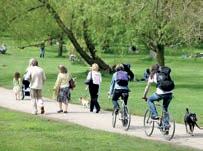
2 minute read
RESTORING NATURE
HARRY GREENFIELD CLA SENIOR LAND USE POLICY ADVISER
harry.greenfi eld@cla.org.uk 020 7460 7937

Defra’s Landscape Recovery scheme in England will involve 10 pilot projects and will initially focus on threatened native species and rivers & streams
he Landscape Recovery
Tscheme, one of the three new Environmental Land Management (ELM) schemes being developed by the government, is the biggest departure from environmental schemes previously delivered through the Common Agricultural Policy.
A decade ago, Professor John Lawton’s nature conservation review stated that, to stem wildlife declines, we need “more, bigger, better and joined” sites for nature. Landscape Recovery aims to make an impact by funding large-scale, long-term land-use change projects that restore natural ecosystems.
Th e scheme will pay to restore or create wildlife habitats that help sequester carbon and boost wildlife, as well as providing many other benefi ts, such as reducing fl ood risk and improving water quality. Woodlands, wetlands, meadows and peatland could all fi t the bill.
Defra will pilot 10 Landscape Recovery projects between 2022 and 2024, on sites of between 500 and 5,000 hectares. Initial pilots will focus on restoring threatened native species and restoring streams and rivers. Applications can come from individual landowners or land managers, as well as groups such as farm clusters and partnerships with other organisations.
Unlike other ELM schemes, Landscape Recovery agreements will be tailor-made to each project. Th is seems a sensible approach: given the length of time, level of investment and scale of these projects, it would be foolish to attempt a one-size-fi ts-all approach. To arrive at a suitable agreement, Defra is also prepared to invest in signifi cant project development funding. Th is could include planning how to monitor the environmental impact and business, governance or legal advice.
Landscape Recovery will also need to make use of private sector environmental funding, with an expectation that pilots will explore the use of ‘blended fi nance’ – combining government funds with private sector investment, such as payments for carbon credits, water management or biodiversity net gain. Interest in natural capital, and the urgency with which the corporate sector is trying to reach net zero carbon emissions, means the time is ripe for land managers to take advantage of this momentum.
Landscape Recovery will not be for everyone. Agreements will be long-term (20- plus years) and the types of activity funded mean that Landscape Recovery is less suitable for members who want to continue productive agriculture on the land.
For this reason, the CLA is wary of suggestions that a third of the ELM budget should be spent on Landscape Recovery, as Defra has indicated it will be. At least during the transition towards the new agricultural period, funding should be directed at improving the sustainability of agriculture and building on the success of previous agri-enviroment schemes, as the Local Nature Recovery scheme will.
But there is still a place for Landscape Recovery to fund those large-scale, ambitious environmental projects that will help us deal with the climate and ecological emergency we face. Th e CLA is lobbying to ensure the scheme is accessible to land managers, not just environmental professionals. Members who have an idea for this sort of transformative land-use change, and are willing to dedicate land towards it, should consider applying for a pilot when the application window opens later this year.










